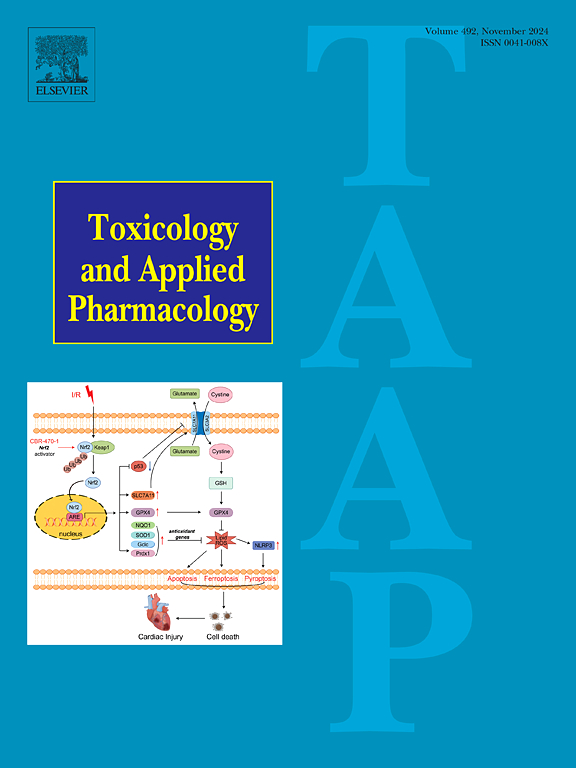升高的SNHG1通过Sox2、Rac1和Slug促进Cd(II)转化细胞的侵袭和迁移。
IF 3.3
3区 医学
Q2 PHARMACOLOGY & PHARMACY
引用次数: 0
摘要
大量研究表明,接触镉[Cd(II)]会导致肺部和其他器官的癌症。镉(II)化合物被列为确认的人类致癌物;然而,Cd(II)诱导的致癌机制仍然知之甚少。小核仁RNA宿主基因1 (SNHG1)是一种长链非编码RNA (lncRNA),已被确定为致癌基因。在这项研究中,我们研究了SNHG1在Cd(II)转化细胞的侵袭和迁移中的作用。我们的研究结果显示,与传代匹配的正常BEAS-2B细胞相比,Cd(II)转化细胞中SNHG1的表达显著升高。沉默SNHG1可降低Cd(II)转化细胞的侵袭和迁移能力,抑制长期Cd暴露诱导的恶性转化。值得注意的是,仅在BEAS-2B细胞中异位表达SNHG1就足以驱动恶性转化,增强侵袭和迁移,强调了其致癌潜力。SRY-box 2 (Sox2)是一种与癌细胞增殖、侵袭和迁移有关的转录因子,在Cd(II)转化的细胞中被发现上调,而SNHG1敲低导致Sox2蛋白水平降低。同样,与肿瘤生长、侵袭和转移相关的细胞骨架动力学的关键调节因子Rac1也在Cd(II)转化的细胞中升高。敲除SNHG1降低了Rac1蛋白水平,敲除Rac1显著抑制了入侵和迁移。此外,我们观察到在Cd(II)转化的细胞中,Slug(一种关键的上皮-间质转化(EMT)转录因子)的表达增加,而其下游靶点E-cadherin的表达减少。综上所述,这些结果表明SNHG1的升高可促进Sox2、Rac1和Slug的表达,从而驱动Cd(II)转化细胞的侵袭和迁移行为。本文章由计算机程序翻译,如有差异,请以英文原文为准。
Elevated SNHG1 promotes invasion and migration of Cd(II)-transformed cells through Sox2, Rac1, and Slug
Numerous studies have shown that exposure to cadmium [Cd(II)] contributes to the development of cancers in the lung and other organs. Cd(II) compounds are classified as confirmed human carcinogens; however, the mechanisms underlying Cd(II)-induced carcinogenesis remain poorly understood. Small nucleolar RNA host gene 1 (SNHG1), a long non-coding RNA (lncRNA), has been identified as an oncogene. In this study, we investigated the role of SNHG1 in the invasion and migration of Cd(II)-transformed cells. Our findings revealed that SNHG1 expression was significantly elevated in Cd(II)-transformed cells compared to their passage-matched normal BEAS-2B counterparts. Silencing SNHG1 reduced the invasive and migratory capacities of Cd(II)-transformed cells and inhibited malignant transformation induced by long-term Cd exposure. Notably, ectopic expression of SNHG1 alone in BEAS-2B cells was sufficient to drive malignant transformation and enhance invasion and migration, underscoring its oncogenic potential. SRY-box 2 (Sox2), a transcription factor implicated in cancer cell proliferation, invasion, and migration, was found to be upregulated in Cd(II)-transformed cells, while SNHG1 knockdown led to decreased Sox2 protein levels. Similarly, ras-related C3 botulinum toxin substrate 1 (Rac1), a key regulator of cytoskeletal dynamics linked to tumor growth, invasion, and metastasis, was also elevated in Cd(II)-transformed cells. Knockdown of SNHG1 reduced Rac1 protein levels, and Rac1 knockout significantly suppressed invasion and migration. Additionally, we observed increased expression of Slug, a key transcription factor invovlved in epithelial-mesenchymal transition (EMT), and decreased expression of its downstream target E-cadherin in Cd(II)-transformed cells. Collectively, these results demonstrate that elevated SNHG1 promotes the expression of Sox2, Rac1, and Slug, thereby driving the invasive and migratory behavior of Cd(II)-transformed cells.
求助全文
通过发布文献求助,成功后即可免费获取论文全文。
去求助
来源期刊
CiteScore
6.80
自引率
2.60%
发文量
309
审稿时长
32 days
期刊介绍:
Toxicology and Applied Pharmacology publishes original scientific research of relevance to animals or humans pertaining to the action of chemicals, drugs, or chemically-defined natural products.
Regular articles address mechanistic approaches to physiological, pharmacologic, biochemical, cellular, or molecular understanding of toxicologic/pathologic lesions and to methods used to describe these responses. Safety Science articles address outstanding state-of-the-art preclinical and human translational characterization of drug and chemical safety employing cutting-edge science. Highly significant Regulatory Safety Science articles will also be considered in this category. Papers concerned with alternatives to the use of experimental animals are encouraged.
Short articles report on high impact studies of broad interest to readers of TAAP that would benefit from rapid publication. These articles should contain no more than a combined total of four figures and tables. Authors should include in their cover letter the justification for consideration of their manuscript as a short article.

 求助内容:
求助内容: 应助结果提醒方式:
应助结果提醒方式:


